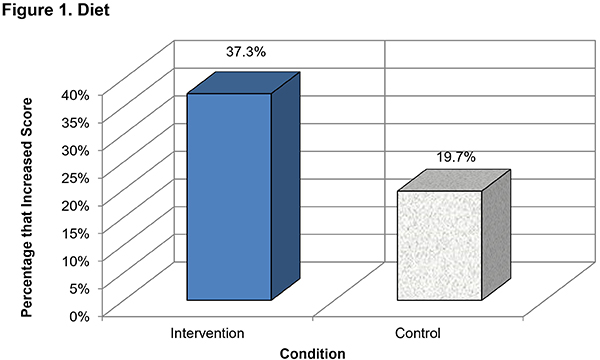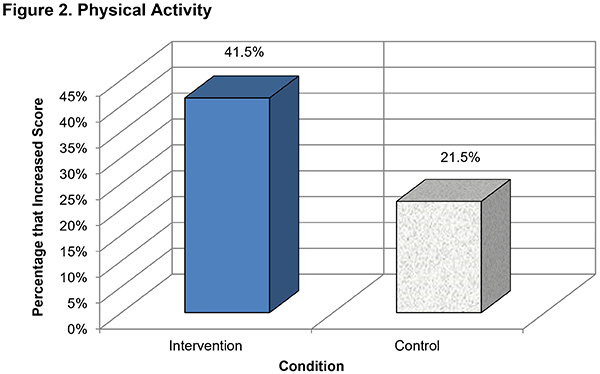Program Synopsis
Designed to promote nutrition, physical activity, and weight loss among women aged 40 and older in rural communities, this community-based intervention provides education on healthy eating and physical activity. The study showed an improvement in diet, physical activity, and body mass index (BMI).
Program Highlights
Program Materials
Preview and order the materials from the developer
Featured Profile
Learn more about this program and the developer who created it
Program Scores
The Need
More than 60 million women in the United States are living with a form of heart disease, the leading cause of death for women. Exercise and good nutrition habits can contribute to a healthy weight and reduce the risks of cardiovascular disease (CVD) and other health-related conditions associated with overweight and obesity, including stroke, type 2 diabetes, and certain types of cancer (e.g., breast, colon, stomach). People residing in rural areas sometimes have less access to healthy foods and fewer opportunities for physical activity than do urban residents. Nutrition and physical activity programs are needed in rural areas to help women meet physical activity recommendations.
The Program
StrongPeople Strong Hearts is a community-based intervention designed to promote nutrition, physical activity, and weight loss among women aged 40 and older in rural communities. The program components are as follows:
-- Training on the intervention for class leaders: Local class leaders (affiliated with a non-profit organization, have current CPR training, and have the appropriate educational and training background) attend a 1-day in-person training session on program facilitation. Over the course of the intervention, they participate in weekly support calls.
-- Educational classes: Over a 6-month period, class leaders teach skills at the individual, social, and environmental levels. Participants attend 60-minute classes twice per week at community settings. The individual-level approach includes learning progressive strength training and aerobic exercises as well as participating in skills-based health education (e.g., nutrition, physical activity, civic engagement). Each class includes activities such as group discussion about building social support for exercising outside of class (social level), grocery store audits, food environment assessments, and community walking audits (environmental level).
The intervention in the reviewed study involved a 1-day in-person training and weekly support calls for class leaders, who facilitated classes over a 6-month period. The current version of the intervention involves a 1-day online training and email support for class leaders over a 3-month period.
Time Required
In the intervention in the reviewed study, class leaders participated in a 1-day in-person training and facilitated two 60-minute classes each week over a 6-month period. They also participated in weekly support calls.
In the current intervention, class leaders take a 1-day online training and facilitate two 60-minute classes each week over a 3-month period. Email support is available to class leaders.
Intended Audience
The intervention in the reviewed study was intended for women aged 40 and older who were either obese or sedentary and overweight. The intervention may be applicable to broader groups.
Suitable Settings
The program is suitable for implementation in community settings.
Required Resources
Required resources to implement the program include the following:
-- StrongPeople Strong Hearts website
For costs associated with this program, click on Contact Program Developer on the Program Materials page.
About the Study
A community randomized controlled trial enrolled eligible participants from 11 rural and medically underserved towns in New York. Towns in the same counties were paired and randomized so that one was assigned to the intervention group and one the delayed-intervention control group. Participants were recruited from their local communities through various outreach methods (e.g., flyers, radio, social media) and enrolled in the intervention (n=87) or to the delayed-intervention (n=95). Eligible participants were women aged 40 and older who were either (1) overweight and sedentary or (2) obese. Women were ineligible if they did not receive permission from their provider to participate, had cognitive impairment, had a disqualifying blood pressure or resting heart rate, or were participating or planned to participate in another health behavior change program. Among all participants, the average age was 57 years; 98% were not of a racial/ethnic minority group.
Participants completed in-person assessments and online health questionnaires at baseline and 6 months later (at the conclusion of the intervention for the intervention group). The primary outcomes were diet, physical activity, and BMI. Diet and physical activity were measured using questions related to diet and physical activity from the American Heart Association’s Life’s Simple 7 questionnaire. Participants self-reported their daily consumption of fruit, vegetables, fish, whole grains, sodium, and sugar-sweetened beverages. A higher score indicated better nutrition. Participants self-reported the frequency and duration of physical activity in the past 7 days, and a higher score indicated more physical activity. BMI was calculated using measures of height taken with free-standing stadiometers and weight taken with Omron scales.
The secondary outcome, CVD risk, was measured using Life’s Simple 7. Participants self-reported data on their diet, physical activity, and smoking status, and researchers measured their BMI, cholesterol, blood pressure, and fasting glucose. These measures were used to calculate a composite score, with a higher score indicating lower CVD risk.
Key Findings

-
The proportion of participants who increased their healthy diet score was greater in the intervention group than in the control group (p=.03).

-
The proportion of participants who increased their physical activity score was greater in the intervention group than in the control group (p=.008).

-
The proportion of participants who decreased their BMI was greater in the intervention group than in the control group (p=.008).
Additional Findings
-
The proportion of participants who increased their total Life’s Simple 7 score was greater in the intervention group than in the control group (p=.03).


